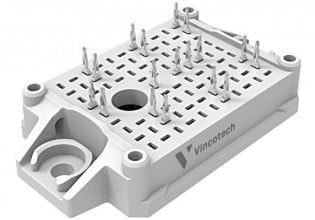Silicon Carbide Tech Improves Efficiency, Lowers Solar Inverter Size/Cost
Navitas Semiconductor and Katek Group have announced that Katek’s coolcept fleX family of Steca solar inverters will use GeneSiC power semiconductors from Navitas for better efficiency, size, and cost.
In a joint release with Navitas Semiconductor, Katek Group has announced they will use Navitas GeneSiC, silicon carbide power semiconductors in their family of Steca branded coolcept fleX residential solar inverters.
Per Katek, the Navitas SiC power switch technology was selected to improve the efficiency of their solar inverters, which translates to reduced size, weight, and cost of the end product. The announcement comes as Katek looks to grow its share with its Steca inverter offering in the rapidly expanding residential solar market.
![]()
Navitas GeneSiC power switches selected for Steca solar inverters. Image used courtesy of Navitas
What Is a Solar Inverter?
In a solar power generation system, solar inverters perform the important function of converting DC power from photovoltaic (PV) cells to usable grid AC power. Conversion from DC to AC is typically accomplished within the inverter using bridge circuits consisting of high-voltage switches and other components.
Sequencing of the switches is controlled through processor logic that delivers command signals to gate drive circuits that turn the FET power switches on and off, generating single or three-phase grid AC power at the output.
![]()
Transformer-less, 3-phase, 3-level, 1200 V solar inverter circuit. Image used courtesy of Navitas
Steca Coolcept FleX Solar Inverter
The coolcept fleX inverter is designed for residential home and apartment solar power applications. Each inverter can deliver up to 4.6 kW of 50/60 Hz, three-phase AC power that can be used directly by loads in the home, stored for later use, or sold back to the grid during periods of production surplus.
Units can accommodate PV array input voltages up to 1000 V, converting solar DC to AC power at 98% efficiency. Single-phase variants based on the coolcept topology are available as well.
According to Katek, the key differentiator for coolcept inverters is efficiency at peak power, achieved through their patented inverter topology and now supported by the Navitas GeneSiC technology.
High efficiency means less heat dissipation during peak power operation. It eliminates the need for external cooling elements that can add to the size, weight, and cost. Important for residential consumer applications that place a premium on size and cost.
Along with competitors like Tesla’s Powerwall, Katek is pursuing a rapidly growing market as solar power capacity, residential and other, is expected to increase threefold between 2022 to 2027, surpassing both coal and gas as the leading source of installed power capacity globally.
![]()
Steca coolcept fleX residential solar inverter. Image used courtesy of Katek
Navitas GeneSiC MOSFETs
With better efficiency and thermal performance at high voltage and temperature, the adoption of silicon carbide power technologies continues to expand at a rapid pace for high-voltage renewable energy production, energy storage, EV, and industrial applications.
GeneSIC FETs from Navitas use patented “trench-assisted planar-gate” technology to deliver high-speed and high-temperature performance that, according to the company, can reduce device case temperatures by up to 25°C and extend operating life by a factor of three.
The trench-assisted planar gate design combines traditional planar and trench approaches to deliver a solution that combines the benefits of both techniques, offering thermal performance and efficiency without compromising on manufacturability, according to the company.
![]()
GeneSiC, trench-assisted planar-gate technology. Image used courtesy of Navitas
Each Steca coolcept fleX inverter will use 16 GeneSiC MOSFETs configured in H4, or full-bridge, inverter circuits to generate three-phase AC power from the solar array. The GeneSIC FETs utilized will be the 1200 V model variants with a nominal resistance of 75 mΩ (G3R75MT12J) in a TO-263-7 package. Each switch is capable of supporting continuous currents up to 75 A.
The larger Navitas GeneSiC FET portfolio features solutions with withstand voltages ranging from 650 V to 6.5 kV, and on-resistances as low as 10 mΩ. Various device packaging options, including bare die, are available.
![]()
G3R75MT12J gate charge circuit. Image used courtesy of Navitas






